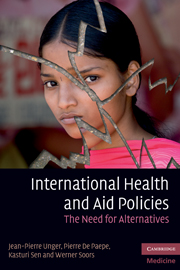Book contents
- Frontmatter
- Contents
- Preface
- Biographies
- Notices
- Acknowledgements
- List of abbreviations
- Reviews
- Introduction: Overview and purpose
- Section 1 Paradigms of international policies
- Section 2 The failure of the aid paradigm: poor disease control in developing countries
- Section 3 Impact of international health policies on access to health in middle-income countries: some experiences from Latin America
- 6 Costa Rica: achievements of a heterodox health policy
- 7 Colombia: in vivo test of health sector privatization in the developing world
- 8 Chile's neoliberal health reform: an assessment and a critique
- Section 4 Determinants and implications of new liberal health policies: the case of India, China and Lebanon
- Section 5 Principles for alternative, publicly oriented health care policies, planning, management and delivery
- Section 6 A public health, strategic toolkit to implement these alternatives
- Conclusions
- Glossary
- Index
- References
8 - Chile's neoliberal health reform: an assessment and a critique
Published online by Cambridge University Press: 06 December 2010
- Frontmatter
- Contents
- Preface
- Biographies
- Notices
- Acknowledgements
- List of abbreviations
- Reviews
- Introduction: Overview and purpose
- Section 1 Paradigms of international policies
- Section 2 The failure of the aid paradigm: poor disease control in developing countries
- Section 3 Impact of international health policies on access to health in middle-income countries: some experiences from Latin America
- 6 Costa Rica: achievements of a heterodox health policy
- 7 Colombia: in vivo test of health sector privatization in the developing world
- 8 Chile's neoliberal health reform: an assessment and a critique
- Section 4 Determinants and implications of new liberal health policies: the case of India, China and Lebanon
- Section 5 Principles for alternative, publicly oriented health care policies, planning, management and delivery
- Section 6 A public health, strategic toolkit to implement these alternatives
- Conclusions
- Glossary
- Index
- References
Summary
Unger J.-P., De Paepe P., Arteaga Herrera O., Solimano Cantuarias G. Chile's Neoliberal Health Reform: An Assessment and a Critique. PLoS Medicine 2008; 5(4) e79: 0001–0006.
Introduction
The Chilean health system has been studied extensively (Jack, 2000). Its current form is the result of a major reform undertaken by the Pinochet government following the coup d'état in 1973. Pinochet's reform established competition between public and private health insurers and promoted private health services, following neoliberal principles. Neoliberalism is an economic and political movement that gained consensus in the 1980s among international organizations such as the IMF and the WB. This movement demands reforms such as free trade; privatization of previously public-owned enterprises, goods, and services; undistorted market prices; and limited government intervention. After the publication of the World Bank's 1993 report, ‘Investing in Health’ (World Bank, 1993), Chile became a model for neoliberal reforms to health services.
In this Policy Forum, we assess the effects of the Chilean reform from Pinochet until 2005, and including the transition to democracy in 1990. We suggest that the use of Chile as a model for other countries of the health benefits of neoliberalism is seriously misguided. We stress the dominant role of the public health system in Chile, while most other studies have assessed the introduction of a private insurance sector as part of the neoliberal reform.
- Type
- Chapter
- Information
- International Health and Aid PoliciesThe Need for Alternatives, pp. 97 - 106Publisher: Cambridge University PressPrint publication year: 2010



